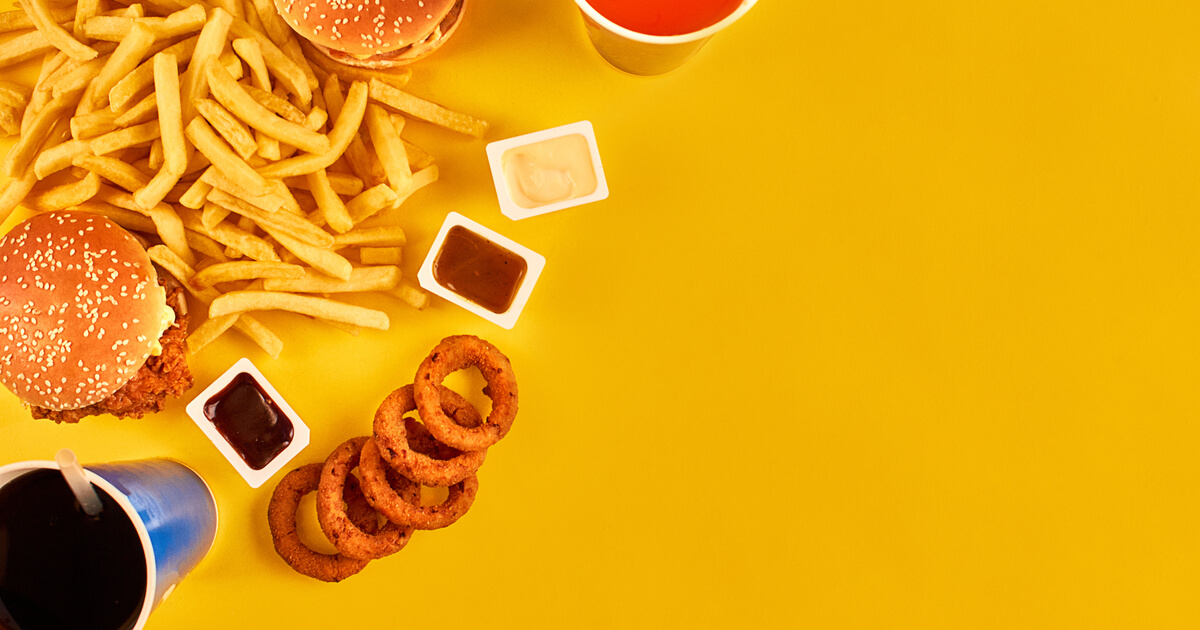November 7, 2022
Scheduled tentatively for October 2023, legislation aimed at lowering the national obesity rates will take full effect in the UK and EU. Specifically, targeting junk food ads. Years in the works, the restrictions will apply to the sale and promotion of high fat, sugar, or salt (HFSS) foods and beverages. And as it turns out, the UK’s attempt to fight obesity should be of particular interest to e-commerce managers.
Google has been enacting parallel restrictions for advertising on its platform. This is significant because while Google’s junk food ads restrictions are still focused on UK consumers, they impact food & beverage (F&B) brands around the world.
And since it’s safe to assume health-related restrictions will only grow online, it’s wise to focus on how some brands are already adapting. As opposed to racing to figure things out in the near future.
Note: The following is not intended as legal advice, and businesses with questions on legal compliance should consult their attorneys.
Businesses affected by the junk food ads ban
The regulations apply to businesses in the UK that employ 50 or more people. This includes online retailers and retailers who don’t primarily sell food or beverages. The regulations also apply to stores that are part of a franchise or symbol groups.
Specialist retailers and small and micro businesses (49 or fewer employees) are not affected.
Restricted HFSS product categories
- Breakfast cereals and morning goods (e.g., croissants, scones)
- Sweet biscuits and bars
- Savory snacks
- Pizza
- Crisps and chips
- Sweetened yogurt
- Ready-to-heat meals
- Pastry products and battered or breaded seafood and meat products
- Cakes and cupcakes
- Desserts and puddings
- Confectionary items (e.g., ice cream)
- Soft drinks
3 ways F&B brands can pivot to meet HFSS regulations
In anticipation of potential changes to regulations around HFSS, keeping ahead of evolving health-related regulations is just one aspect of F&B brands’ larger challenge: Learning how to thrive in an increasingly health-conscious world.
There’s three main pillars F&B marketers can (and should) focus on to drive sales as HFSS begins to take shape.
1. In advertising
The ban on digital advertising for HFSS foods leaves massive opportunity for F&B marketers to try a new approach. With brands being restricted in their own messaging and outreach, why not let your brand advocates do the talking for you?
We’re talking about user-generated content (UGC) — like customer reviews, images, and social posts. UGC isn’t only a way to let your customers do the heavy lifting for you, it’s also a surefire way to boost conversion, in-store and online (more on that to come).
While you may not be allowed to post certain adverts, your customers can. Let shoppers fill their social pages with authentic imagery of your products, and display these on your own social channels, product pages, and beyond.
There’s a number of simple ways to collect UGC. With a sampling campaign you exchange a product sample in exchange for an honest customer review. Or an automated review request email will invite customers to leave a review for in-store and online purchases. You could even turn to employee advocacy and let your employees share UGC on their social feeds for you.
However you slice and dice it, UGC will keep your sales healthy in spite of the new regulations. Just remember that UGC is still considered as a form of advertising, and like all advertising, there’s regulations and best practices to follow.
2. On the physical and digital shelf
With the gap between the physical (in-store) and digital (online) worlds closing, and 64% of consumers having hybrid shopped in the past six months, brands need to meet shoppers where they are. Especially given that HFSS legislation is going to have an impact on both shelves.
In-store, products can no longer be promoted around checkout areas, the ends of store aisles, and in the vicinity of store entrances. Basically anywhere considered a “high-impulse purchase” area. Instead, items like confectionery are being placed into aisles where there’s increased competition for customer attention.
Note: While the promotion and sale of these products is restricted, promotion of the brands that represent them isn’t. Meaning, a business couldn’t place a sign promoting Coke or Pepsi products near its front door. But a Coke or Pepsi sign featuring only a brand logo would be allowed.
It’s the same story online too. For UK consumers browsing and shopping for F&B products online, the restrictions on junk food ads are meant to mimic businesses’ brick-and-mortar counterparts.
Firstly, affected businesses can’t promote HFSS products on their landing page(s). They also can’t promote HFSS products to UK customers who are browsing other categories of food, when customers view their shopping basket, or on a “proceed to payment” page.
Brands need to find a way to maintain share of basket size and add-to-cart rate in this new normal. While a ratings and reviews program isn’t anything new, their value is often underestimated.
Ratings and reviews play an essential part of the shopper journey, with 88% of consumers consulting them before making a purchase. Historically, this only affected the digital shelf but our 2022 Shopper Experience Index tells us that 63% of shoppers research online before entering a store. Many even pull out their phones in-store to check.
So ensuring you have a strong ratings and reviews program, that’s constantly updated and syndicated across all your channels, will ensure you’re inspiring consumers to make purchases wherever they are.
3. With product shifts
One way to workaround incoming legislation is to develop new HFSS-compliant products. Some retailers, like Mars Wrigley UK, are already doing this. Mars has launched a range of non-HFSS chocolate bars, specifically aimed at adhering to government regulations.
But launching a new product, especially in today’s climate, can be tricky. Mars alone said its UK team spent, “thousands of hours working on every minute detail of the bars.” Not everyone has thousands of hours to spare though. What if you only have a fraction of that? You’ll need to glean shopper opinions fast and learn customer sentiment about new products.
Brands, especially SMBs, are doing this with feedback found in ratings and reviews. Reviews don’t just help drive conversion, they often contain valuable insights.
Bazaarvoice customer Rael, for example, uses reviews to mine customer sentiment about new products and identifies ways to turn this feedback into action.
“UGC guides essential parts of overall marketing strategy by showing us how to speak about each product and position them based on what consumers like. Sometimes your customers tell you things that you didn’t consider on our own” — Sorah Park, CMO, Rael.
You’re already collecting reviews to display on your channels (if not, you should be). Using insights from these reviews to improve products will ensure they land with a bang and you won’t lose any basket size in the HFSS world.
Google brings the anti-obesity battle into the cloud
It’s here, with some fairly modest regulations, where the UK’s HFSS restrictions end. But, non-coincidentally, this is where Google’s new rules begin. In turn, expanding the front lines in the war on “junk food ads” and setting a new digital marketing precedent in the process.
Google’s junk food ads restrictions started much the same way those in the UK had, with self-regulation.
Starting in October 2020, F&B marketers gained access to a self-declaration option for their accounts. By allowing marketers to flag their own content as HFSS related, Google ensured the way it served ads to UK consumers was compliant well before the UK’s regulations take effect.
In doing so, junk food officially joined Google’s list of other regulated content, including alcohol, cigarettes, and gambling. But this was only the first step for the ubiquitous search and advertising giant.
In 2021, Google announced additional HFSS-related restrictions, and these weren’t voluntary. Marketers could no longer target minors in the UK or EU with Shopping ads containing HFSS content. Google stated these new restrictions applied to any Shopping ad featuring at least one HFSS food item, beverage, or meal in the ad itself. Or at the destination site of the ad. Thus, closing the loophole for brands that tried to display a logo but not a specific product.
For F&B brands, Google’s new rules seemed like the start of a trend to regulate how HFSS products can be marketed across the web. Fortunately, F&B marketers can learn from brands already in the process of embracing healthier products and marketing strategies.
F&B brands embrace ways to pivot from junk food ads
In anticipation of potential changes to regulation around HFSS, keeping ahead of evolving health-related regulations is just one aspect of F&B brands’ larger challenge: Learning how to thrive in an increasingly health-conscious world.
That’s why it’s beneficial to study how multiple brands are making this change.
1. Mondelez International: Setting the table with a more balanced portfolio
One option for companies that own multiple brands is to shift their acquisition strategy to focus on healthy products. Citing, in part, the obesity-related concerns touched on above, Mondelez International is investing billions in new and healthier offerings to a product portfolio that includes Oreo, Cadbury Chocolates, and Toblerone.
As CEO Dirk Van de Put explains, “If you talk about health and wellness … for sure we want to launch brands, but launching new brands is not easy and acquiring brands that already have the prestige and the client base, and are starting to develop, is easier.”
Part of this strategic shift included Mondelez reducing its stake in soft drinks and coffee maker Keurig, Dr Pepper, and JDE Peet’s in 2020. And in addition to the re-allocations to healthier products, Mondelez is also advocating for healthier approaches to eating more generally, including mindful snacking and portion control.
2. Coca-Cola: Working out healthier products (and ways to promote them)
Another option for brands is to develop and highlight healthier versions of their existing product line. The beverage industry has been at the forefront of this trend.
Diet or not, soft drinks aren’t the first thing that comes to mind when you think “wellness.” But soft drink brands specifically have been racing to keep up with increasingly health-conscious consumers. For example, in 2016, Coca-Cola was already working on launching a marketing strategy aimed at increasing awareness of its zero-sugar and reduced-sugar beverages.
According to a company representative, “We recognized an opportunity to give Coke Zero a boost and encourage more Coca-Cola fans to try a delicious zero-sugar product. Through in-house innovation, we developed an even better-tasting recipe that delivers real Coca-Cola taste with zero sugar and zero calories.”
While Coke’s pivot to a lite version of its flagship product is inspiring, anyone inside knows that improving well-established products and expanding to other offerings is challenging and complicated. Customers are finicky, and it’s hard to get them to step outside their comfort zone to try something new. That’s why many F&B brands leverage product sampling to test new products and reinvigorate old ones.
In 2021, Coca-Cola used product sampling to raise awareness of its very first energy drink. In-store sampling in the early months of COVID was a non-starter. So, Coke took advantage of the groundswell of online grocery pickup services by including a free sample in every order.
Soon, other big F&B brands like General Mills and major retailers like Walmart began to embrace this modern take on traditional product sampling, creating new revenue streams in the process.
3. Zevia: Harnessing the power of UGC and influencer marketing
While giant multinationals try to change their products and their images, the shift toward wellness has created an opening for smaller F&B brands. Zevia, a healthy upstart in the carbonated soft drink (CSD) category, is using modern marketing to build on its reputation as a healthy alternative to sugary sodas.
For Zevia, the key has been positioning a product with an unfamiliar ingredient (stevia) as something recognizable (flavors like cola and ginger ale).
Writing for HBR in 2013, CEO Paddy Spence explained, “a healthy alternative’s best chance for success lies in keeping the product familiar, which allows you to educate consumers quickly and cost-effectively. Most purchasing decisions in packaged goods are made at the shelf, so it’s critical for shoppers to easily identify how a new product fits into their diet.”
Now, nine years later, user-generated content (UGC) and influencer marketing are proving to be a perfect complement to Zevia’s “familiarity” approach to marketing.
In addition to celebrating fans of the brand on their own Instagram feeds, Zevia actively reaches out to partner with health-conscious influencers. Together, they create and feature unique drink recipes using Zevia, encouraging followers to share mini-reviews and their own recipe ideas.
What’s more, Zevia also partners with other influencers in fashion, mommy blogs, and lifestyle categories. By doing so, Zevia proves a healthy CSD brand can transcend its own category to play a more holistic role in the broader health and wellness market.
Healthy marketing works (you just need the right amount of influence)
As more health-related regulations converge with consumers in search of healthier living, and junk food ads are increasingly banned, the food and beverage industry will only get more interesting. And this is why it’s so important to learn from the F&B brands working on pivoting now.
But what brands are doing is only part of the puzzle e-commerce managers need to solve. The other part is learning how modern tactics like user-generated content and influencer marketing pay off for brands who use them correctly.
Learn more ways to stand out in food & beverage on our dedicated F&B page.










